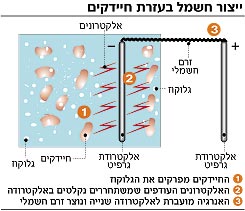Biology / American researchers built a device that translates the activity of bacteria from the "iron-breathing" family into an electric current
Yuval Dror

American scientists from the University of Massachusetts announced this week that they succeeded in building a prototype of a device capable of translating the biological activity of bacteria (Bacteria, one of the types of bacteria) into an electric current. Although the current strength is low, the prototype is able to operate without interruption and for an unlimited period of time - as long as the bacteria receive a supply of sugar.
The bacterium on which the device is based, "Rhodoferax Ferrireducens", was discovered in drilling in Oyster Bay, Virginia. It belongs to the "Iron Breathers" family, so named because they rely on iron to survive - and not on oxygen. The bacterium is unique in its ability to completely break down sugars, without using oxygen. In its natural environment, it breaks down sugars as part of the "respiration" process - a biochemical process in which glucose (grape sugar) is broken down and the excess electrons of the glucose molecule are transferred to an iron compound in the environment. The transfer of electrons creates energy that allows the bacteria to exist and is released as heat.
The scientists, who published their research in the latest issue of the magazine "Nature," Biotechnology decided to utilize the process of transferring electrons to create electricity. They grew a colony of Rhodoprax pyridoscens on a graphite electrode, which was placed in a sealed glass container containing a glucose solution. In a short time, the bacteria began the process of breaking down the glucose and released the electrons to the electrode. As a result the electrode is charged with a negative charge. When the researchers connected the charged electrode to a second electrode with a cable, an electric current was created.
According to the researchers, this is not the first time that an attempt has been made to take advantage of the natural process of releasing electrons in the "breathing" process of bacteria, but in the previous attempts, only a few percent of the electrons were able to be transferred to the device that received them. This time the researchers from Massachusetts managed to use 80% of the electrons generated in the process.
But there is still a long way to go, until the day when electronics stores offer a bag of bacteria as a replacement for batteries: the process is very slow and the strength of the electric current generated is low. "Although the process is efficient, it is slow and it is not a large flow. He is barely enough to run a calculator," the researchers wrote. However, they noted that replacing the electrode with a different one, which allows more bacteria to touch it, increases the strength of the current. The prototype he built worked for 25 days without a break, and is able to run a 60 watt bulb for 17 hours - on one cup of sugar.
The main advantage of the process is that it is completely natural. There are many different sugars in nature, and the researchers' tests show that the bacteria know how to break them down. The US Department of Defense, which financed part of the research, hopes that the bacteria will make it possible to operate equipment located in remote areas without regular maintenance to replace the batteries - as in the case of underwater microphones. What's more: electrical devices based on the activity of bacteria may be used in the distant future as a solution for populations far from any other source of electricity.
Scientists are now trying to use genetic engineering methods to make bacteria produce more electricity. The newspaper "Boston Globe" reported that at least one company contacted the scientists in order for them to check if it is possible to produce electricity from pig droppings. "There is a scene in the movie 'Back to the Future' where the heroes throw a banana peel into the fuel tank of the car and set off," said microbiology professor Derek Lawley from the University of Massachusetts. "We are not yet at this stage, but we have taken a big step forward."
